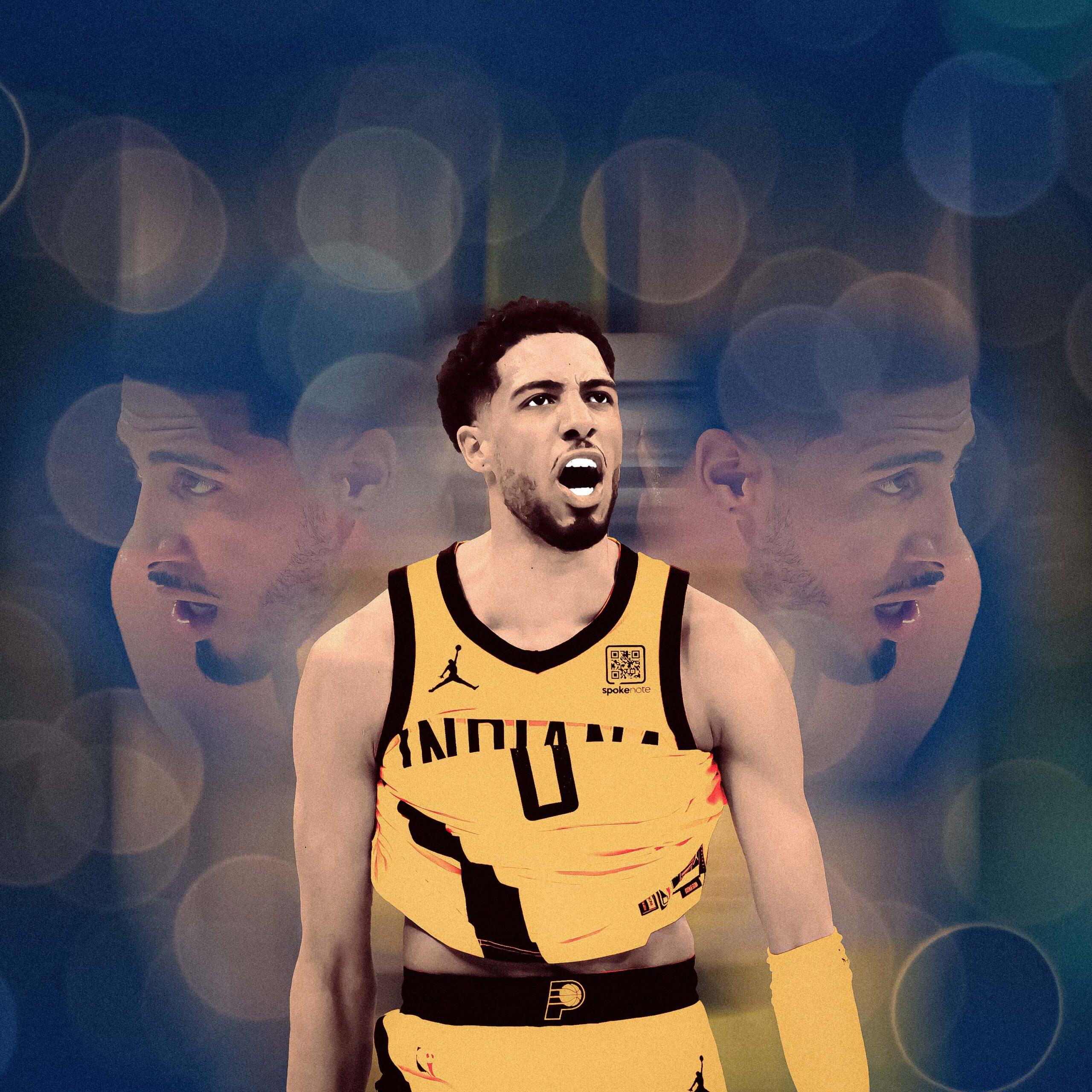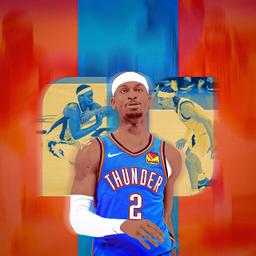
Tyrese Haliburton was leaping to his right, his body drifting into the corner, his legs splayed, and his fingers launching one of those impossibly high, weirdly angled shots that look doomed. That is, until you remember who’s shooting it, until you remember all the weirdly angled, impossible shots that came before it, and until this particular shot somehow finds the bottom of the net. Because of course, it does.
If there’s anything we’ve learned this postseason, it’s that no shot from Haliburton is too weird or difficult (especially in crunch time), and no lead against the Indiana Pacers is ever safe (ask the Bucks and Cavaliers and Knicks). And if you saw this particular wild 3-point swish from Haliburton late Sunday night—sans context—you could easily have believed that another storybook victory was underway.
But aesthetics aren’t everything, and looks can be deceiving. This shot, which cut the Oklahoma City Thunder’s lead to 17 points with about four minutes to play, was too little, too late. Seconds later, Haliburton would be called to the bench, where he’d helplessly watch the final moments of a 123-107 Pacers defeat in Game 2 of the NBA Finals.
The Pacers departed Oklahoma late Sunday with a split in the series but also some big, nagging questions: Can their all-for-one, one-for-all ensemble approach to basketball get them three more wins against the Thunder, who are stacked with elite defenders and led by the league’s MVP and most lethal scorer?
And more specifically: Can Indiana win the title if the Thunder bottle up Haliburton this emphatically?
The latter question is probably a bit unfair, as it’s based on a common but reductive premise—that NBA superstars have to lead with gaudy counting stats. And Haliburton, for all his playoff heroics, isn’t a gaudy-stats guy. But he is the Pacers’ biggest star, their emotional leader, and the main engine of their offense, whether he’s making plays or scoring. Which means that he will surely be the primary target of criticism on nights the Pacers sputter as badly as they did on Sunday.
Haliburton scored 17 points but managed just five through the first three quarters as the Thunder built a 23-point lead. He went just 1-for-5 in the first half before finding his range late and going 6-for-8 in the second, but the Pacers never got the game within single digits. His six assists (four in the first three quarters) were essentially offset by five turnovers, in what was easily his sloppiest game of the postseason.
Pacers coach Rick Carlisle, who has navigated his fair share of playoff games and media narratives in 23 seasons leading NBA teams, knew what was coming after the loss and seemed primed to douse the Game 2 critiques before they landed.
“There’s a lot more to the game than just scoring,” Carlisle said tersely when asked about Haliburton’s struggles. He said that the Pacers needed more from Pascal Siakam and Myles Turner, too, and from the rest of the rotation. “So people shouldn’t just look at [Haliburton’s] points and assists and judge how he played or judge how any of our guys played just on that. That’s not how our team is built. I mean, we are an ecosystem that has to function together. And stats—we’ve got to score enough points to win the game—but who gets them and how they get them is not important.”
And this brings us to the conundrum of the Pacers as an elite team—indeed, the conundrum of a title contender built around one modest-usage, reliably selfless superstar. Their greatest asset is, to use Carlisle’s word, their ecosystem—a whirling, high-paced, pass-happy, everyone-touches-the-ball attack that keeps defenses off-balance by never giving them a single target to stop. At its best, it’s efficient and devastating, enough to offset the Pacers’ lack of a true big-time scorer. But when it sputters … well, you get what happened Sunday night.
The beauty of Haliburton’s game is that he can make you forget all of that with a single late-game scoring flurry or—as in Game 1—a single swish with three-tenths of a second left. But the fact is that this series has been a struggle for him, regardless of the 1-1 tie. He’s had eight turnovers so far, his most in a two-game stretch since March of last year. He’s had just 12 assists in the series—one fewer than he had in Game 6 of the Eastern Conference finals.
Credit the Thunder’s whirling, high-paced, suffocating defense and constant rotation of elite play stoppers, from Lu Dort to Cason Wallace to Jalen Williams, all of whom spent time harassing Haliburton, either individually or as a collective. He rarely saw even a hint of daylight. Some of his late scores came on deep 3s, before defenders had a chance to target him.
“Me playing off the pitch a little bit more, flying around,” Haliburton said of what works, rather than relying on ball screens that allowed the Thunder “a chance to really load up, pack the paint.” (Also, he noted, “I had some really dumb turnovers tonight.”)
And now will come the recriminations and the hot takes, the blowhards demanding that Haliburton “step up” and shoot more, attack more, and magically transform himself into some sort of Kobe Bryant clone, because that’s what we’ve been conditioned to expect from our NBA superstars, particularly in the Finals. More shots, more scoring, more aggression.
But that isn’t Tyrese Haliburton’s game, or the reason for his ascension to stardom, or the way the Pacers won 50 games this season. He averaged a modest 18.6 points per game in the regular season (the second lowest of any All-NBA player) and had a usage rate of just 21.6 percent (tied for 82nd among all players who qualified). He doesn’t dominate the ball or the offense. And it would be foolish, at this stage, to suddenly expect him to do so.
Yes, Haliburton has had four game-winning shots in this postseason. Yes, he’s been as clutch as any star in recent memory. Yes, the Pacers are now 27-28 (in the regular season and playoffs) when Haliburton scores fewer than 20 points and 32-4 when he breaks the 20-point plateau. Yes, he has scored 30-plus in three games in these playoffs, including in his legendary Game 1 takedown of the New York Knicks in the conference finals and Game 4 of that same series. But that’s not his calling card.
Aside from the last few minutes of Game 1, the Thunder have dominated the first two games of the Finals, with Shai Gilgeous-Alexander absolutely carving up the Pacers. His 72 points in the series are the most ever by a player in his first two Finals games, according to the NBA, one point more than Allen Iverson scored in the first two games of the 2001 Finals. As Carlisle noted Sunday night, “Shai, you can mark down 34 points before they even get on the plane tomorrow.”
But that isn’t Haliburton. Sure, his stardom is tied to his uncanny shotmaking. But he isn’t a scorer by trade. He isn’t a high-usage guy or the kind of player you ask to carry an offense single-handedly. He’s more Jason Kidd or Steve Nash or Rajon Rondo than James Harden.
The Pacers, a fourth seed out of the East, weren’t supposed to be here. They weren’t supposed to beat the 64-win Cavaliers or their more talented archrivals, the Knicks. They weren’t supposed to win Game 1 in the final second. Haliburton was never supposed to be Gilgeous-Alexander and probably never will be. The Pacers are here because everyone moves the ball, everyone shoots, and everyone contributes, from Siakam to Turner to Andrew Nembhard to Aaron Nesmith to T.J. McConnell to Obi Toppin.
Haliburton is indisputably the Pacers’ best player, their most vital player, and the one who can, on a given night, manifest a miracle. He might need a few more to win this series and the championship. But it’s foolish to expect a consummate playmaker to suddenly morph into a traditional scorer. That’s not Haliburton, and that’s not the Pacers’ formula. For better or for worse, this isn’t a star system. It’s an ecosystem.



